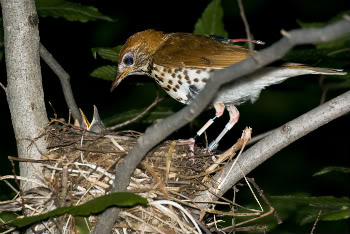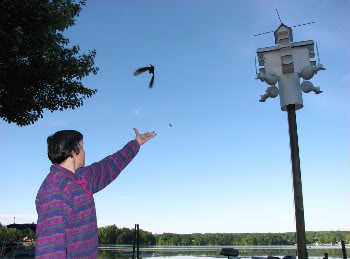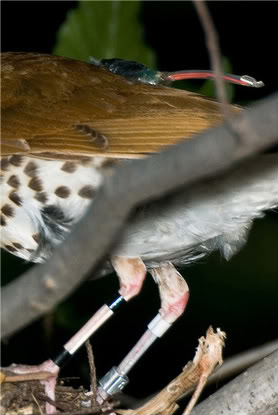Songbirds astonish scientists with speed of their migration, covering 311 miles a day
Using extra tiny geo-locator backpacks, researchers have tracked songbirds’ seasonal migrations for the first time, according to research published in Science . The researchers discovered that these beloved birds fly faster and further than anyone ever imagined.
Bridget Stutchbury and her team attached the geo-locator backpacks to 14 wood thrushes and 20 purple martins in Pennsylvania in 2007. In the summer of 2008 the scientists were able to retrieve the geo-locators from five of the wood thrushes and two of the purple martins.
 A male wood thrush feeds its young while wearing a miniaturized geolocator backpack. Fourteen wood thrushes wore the devices for the long trip to the tropics and back in groundbreaking research on songbird migration. The research was led by Bridget Stutchbury of York University in Toronto and partly funded by National Geographic. Photo by Elizabeth Gow. |
“Never before has anyone been able to track songbirds for their entire migratory trip,” said Stutchbury, a professor of biology in York’s Faculty of Science & Engineering. “We’re excited to achieve this scientific first.”
The data taken from the geo-locators surprised everyone. Stutchbury and her team discovered that during their migrations between Pennsylvania and South America songbirds flew more than 311 miles a day, three times higher than previous estimates. In addition, they found that the songbirds were more leisurely about their fall migration: the return migration to Pennsylvania in the spring ran between two and six times faster than the fall migration.
“We were flabbergasted by the birds’ spring return times. To have a bird leave Brazil on April 12 and be home by the end of the month was just astounding. We always assumed they left sometime in March,” Stutchbury said.
 With hopes of recapturing the bird next year, biology professor Bridget Stutchbury of York University, Toronto, releases a purple martin outfitted with a tiny geolocator for its round-trip migration. Two purple martins — as well as five wood thrushes — returned to their starting place in Pennsylvania, allowing scientists to reconstruct their routes. The research was partly funded by National Geographic. Photo by John Tautin, Purple Martin Conservation Association |
Now that researchers have discovered for the first time where specific songbirds are wintering, the data could have large conservation implications.
“Tracking birds to their wintering areas is also essential for predicting the impact of tropical habitat loss and climate change,” she said. “Until now, our hands have been tied in many ways, because we didn’t know where the birds were going. They would just disappear and then come back in the spring. It’s wonderful to now have a window into their journey.”
Songbird populations have been in global decline for decades. A number of possible causes have been identified, including increased uses of pesticides, habitat loss due to deforestation and urban sprawl, acid rain, feral and pet cats, and exotic plants. However having data as to where the birds migrate—and stops along the way—should allow scientists to pinpoint the exact causes for declines in specific species. Using this new data, researchers hope to create effective conservation programs.
 Detail of miny geo-locator backpack and straps around the legs and feet to keep it securely on the wood thrush.Photo by Elizabeth Gow. |
Studying songbird migrations had proven impossible until now, since the birds were too small to be picked up satellites, the traditional method of tracking migratory birds. It was when Stutchbury discovered that the British Antarctic Survey had developed geo-locators smaller than a dime that the impossible suddenly became a reality. The geo-locators detect light, allowing Stutchbury and her team to employ sunrise and sunset times to decipher the songbirds’ latitude and longitude during their migration.
“The [British Antarctic Survey] hadn’t really been thinking of [attaching them to] songbirds, but when I saw the technology, I knew we could do this,” she said.
CITATION: Bridget J. M. Stutchbury, Scott A. Tarof, Tyler Done, Elizabeth Gow, Patrick M. Kramer, John Tautin, James W. Fox, Vsevolod Afanasyev (2009) Tracking Long-Distance Songbird Migration by Using Geolocators. Science, Volume 323.
Related articles
The end of migrations: wildlife’s greatest spectacle is critically endangered
(07/28/2008)
If we could turn back the clock about 200 years, one could watch as millions of whales swam along their migration routes. Around 150 years ago, one could witness bison filling the vast America prairie or a billion passenger pigeons blotting out the sky for days. Only a few decades back and a million saiga antelope could be seen crossing the plains of Asia.
Rare giant bat eats night-flying birds
(02/13/2007)
A new study published in PLoS ONE, an open online journal, reports that nocturnally migrating songbirds are preyed upon by giant bats. The findings go against the belief that night-flying birds lacked predators.
City life causes song birds to change their tune
(12/04/2006)
Cities cause birds to change their songs according to research published in the December 5th issue of the journal Current Biology.